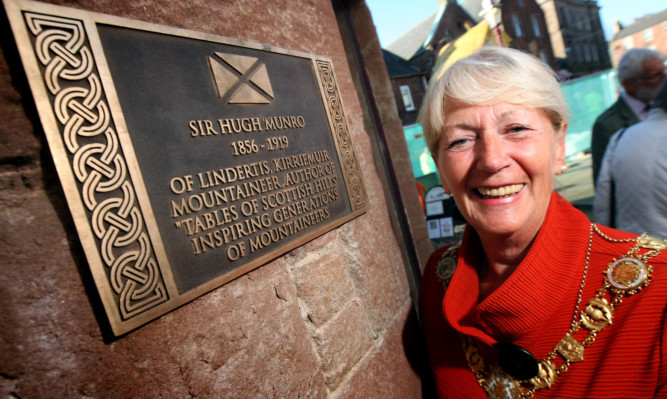The man who first charted and gave his name to Scotland’s highest peaks has been honoured in Kirriemuir.
Angus provost Helen Oswald unveiled a commemorative plaque to Sir Hugh Thomas Munro at the Gateway to the Glens Museum.
Sir Hugh was born in London in 1856 as the eldest of nine children of Sir Campbell Munro, 3rd Baronet of Lindertis, Kirriemuir, and his wife Henrietta.
As a 17-year-old, Sir Hugh went to Stuttgart to learn German and fell in love with the Alps and with mountains more widely.
In 1880 he went to South Africa and became Private Secretary to Sir George Colley, then governor of the Natal province.
He returned to Kirriemuir, and took on the role of managing the family estates, first on behalf of his uncle, Sir Thomas Munro, then on behalf of his father.
There he became active in politics, standing in 1885 for the constituency of Kirkcaldy Burghs and organising the Conservative and Unionist Party, though the cause was unpopular in Scotland.
He worked hard at organising the local political life in Forfarshire, and also served on the County Council.
More important to his legend, he helped found the Scottish Moutaineering Club in 1889, and in September 1891 published his now famous Tables of Heights over 3000 Feet, a list of 283 separate 3,000-feet mountains.
Sir Hugh was fascinated by mountain topography and was a compulsive note-taker, particularly regarding the views from a summit.
Over the next two and a half decades he constantly checked and modified his data.
In 1921, two years after his death, a second version of the Tables appeared largely incorporating his refinements.
This listed 276 Munros and a total of 543 Tops.
A 1974 version gave 279 Munros and a total of 541 tops.
Other versions with modifications appeared in 1981, 1984, 1990 and 1997.
During the First World War, he relocated to Tarascon, in the south of France, running a canteen for French troops where he eventually succumbed to a bout of pneumonia.
His body was returned to Scotland and was buried near Lindertis, in Angus, on April 2 1919.
Munro’s untimely death in France meant he fell fractionally short of climbing all of his own list of peaks and tops.
In a short piece written in 1917 for the Cairngorm Club Journal, he remarked: “I still aspire to stand on the summit of the only three ‘tops’ in Scotland exceeding 3,000 feet in height which I have not yet climbed.”
The Rev A E Robertson completed the first round of the Munros in 1901.
Since then, over 4,000 people have completed the Munros, enjoying the challenge and exercise along the way.
Many have their names and dates, along with a unique Munroist Number, recorded annually in the Scottish Mountaineering Club Journal and at www.smc.org.
Members of the SMC assisted with the wording of the Kirriemuir plaque.
The plaque was commissioned by Historic Scotland as part of their Commemorative Plaques scheme which began in 2012.
All nominations recognise people who have made a significant contribution to Scotland and its people.
